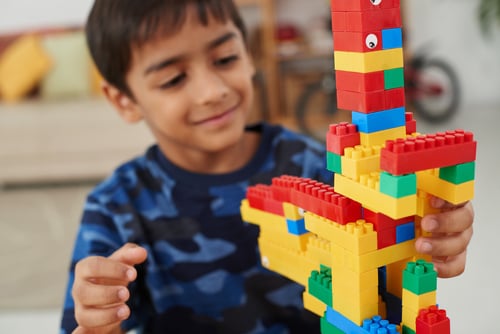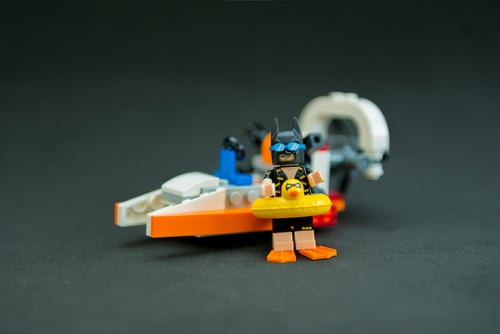Activity
Design Challenge: Building a Bridge
This activity is a great introduction to design thinking because it will capture your child’s interest in a way that is fun and empowering. The challenge is to design a bridge that is made of marshmallows and toothpicks. The bridge must be able to connect two tissue boxes that are spaced six inches apart.
We have included step-by-step guidelines of the design thinking framework. Your job is to help your child through the design thinking process by teaching them the importance of empathy, brainstorming, and prototyping. This activity is aligned to the following NGSS: K-2-ETS1-1, K-2-ETS1-2, K-2-ETS1-3.
Grade
Subject
Thank you for your input.
What You Need:
- Marshmallows
- Toothpicks
- Two tissue boxes of the same size
- Tape measure or ruler
- Pencil and paper for note-taking
- Optional: a small piece of cardboard (about the size of a playing card)
- Optional: at least 20 pennies (feel free to add more)
What You Do:
- Explain the design challenge to your child. Tell them they have been asked to design a bridge that connects two tissue boxes that are spaced six inches apart. The bridge should also stand on its own without falling down.
- Allow your child to place the tissue boxes six inches apart with a ruler so that they can better visualize the challenge.
- Next, ask your child to define a bridge and its purpose. If you’d like, feel free to look at pictures of bridges online so that your child can see a variety of designs. Some questions you can ask your child include:
- What is the purpose of a bridge? (Potential answer: A bridge is a structure that connects two pieces of land across water. A bridge must be able to carry cars and other objects on it, and it must be able to stand on its own over a body of water.)
- What, specifically, is the purpose of your bridge? (Answer: To connect two tissue boxes that are six inches apart and to stand on its own.)
- Allow your child to ideate. Give them a pencil and a piece of paper, and ask them to brainstorm various designs of bridges they can make using toothpicks and marshmallows.
- If your child has a difficult time drawing or writing their ideas, feel free to talk it through with them while you write their ideas down on paper.
- After your child has finished brainstorming, tell them to choose the design they think will work best. Refer back to their answers from step 2, and ask them to prioritize the purpose of the bridge when choosing a design.
- This is an important step of the design thinking process because it teaches your child to prioritize the functionality of their design over their personal preferences. This also prevents them from getting too emotionally attached in case their design doesn’t work.
- Now, for the fun part: prototyping, or building! Give your child the marshmallows and toothpicks, and let them begin making their bridge.
- Allow your child to work independently as much as possible, but be sure to help out wherever is needed.
- Finally, it’s time to test your child’s prototype. Place the tissue boxes six inches apart and place the bridge on top. Ask your child the following questions while they test out their bridge:
- Does the bridge you created stand on its own without falling?
- Does the bridge connect the two tissue boxes?
- If your child’s bridge is unsuccessful in any way, make sure that they aren’t discouraged. Frame their failure as an opportunity to try again, and help identify what parts of their design they need to improve. Take your child back to the start of the design thinking process, and repeat these steps until they have created a bridge they are proud of!
- If your child’s bridge is successful, try placing a piece of cardboard on top of the bridge and add pennies to it until the bridge fails. Then, challenge your child to build a new design that can hold more pennies than their previous design.
Related learning resources

Building Brick Challenge: Build a Tall Tower
Activity
Building Brick Challenge: Build a Tall Tower
In this activity, your child will be challenged to build a tall tower out of building bricks! The instructions include questions prompts to guide students through the design challenge.
1st grade
Science
Activity

Building Brick Challenge: Make a Face
Activity
Building Brick Challenge: Make a Face
In this design challenge, your child will use building bricks to create a funny face.
preschool
Science
Activity

Building Brick Challenge: Build a Boat
Activity
Building Brick Challenge: Build a Boat
Develop your child's mathematical and engineering skills with this fun building brick challenge. In this activity, your learner will be challenged to create a boat out of building bricks.
1st grade
Science
Activity

Design Challenge: Gumdrop Towers
Activity
Design Challenge: Gumdrop Towers
In this fun design challenge, your child will get creative with making structures out of toothpicks and gumdrop candies.
kindergarten
Science
Activity

STEM Design Challenge: Plan, Reflect, Revise
Worksheet
STEM Design Challenge: Plan, Reflect, Revise
Children will plan our their STEM design, reflect on the process of building their creation, and brainstorm ways they could make their design even better.
preschool
Science
Worksheet

STEM Design Challenge Cards
Worksheet
STEM Design Challenge Cards
These STEM design challenge cards ask learners to build something new for a specific reason or purpose and are a great way to foster creative thinking.
2nd grade
Science
Worksheet

Chair Design Challenge
Activity
Chair Design Challenge
In this activity, your student will be invited to build a chair out of building blocks that is designed to meet the specific size and shape of a small doll or toy figure.
2nd grade
Science
Activity

Color Tower Bridge
Worksheet
Color Tower Bridge
A coloring page of Tower Bridge, a famous London landmark. Made for elementary school students studying geography.
1st grade
Social studies
Worksheet

Bridge Over Troubled Water
Science project
Bridge Over Troubled Water
This science fair project idea explores how length affects the weight a bridge can hold.
1st grade
Science project

Design Challenge: Making a Catapult
Activity
Design Challenge: Making a Catapult
In this activity, your child will be challenged to use simple materials to create a catapult for a small, lightweight toy.
preschool
Science
Activity

Brooklyn Bridge Coloring Page
Worksheet
Brooklyn Bridge Coloring Page
Future world travelers can get a head start with this Brooklyn Bridge coloring page.
1st grade
Social studies
Worksheet

London Bridge Subtraction
Worksheet
London Bridge Subtraction
If one bridge falls down, how many bridges are left? None! Help your preschooler sort out simple subtraction with this nursery rhyme math worksheet.
preschool
Reading & Writing
Worksheet

